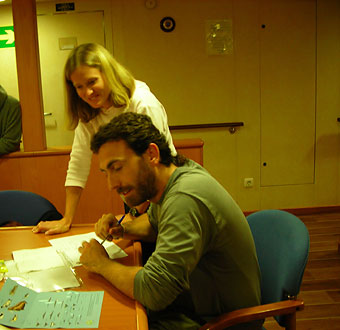

 | |||||||||
|
|
Journals 2007/2008Megan O'Neill
July 30, 2007 My alarm goes off and it was bizarre to see that it says "3:30am". Fortunately, the boat was no longer rocking as much as it was when I went to sleep, but still more than when we left Longyearbyen. I made my way to the research lab ready to start and the 1st shift was finishing up their test runs of the multibeam sonar equipment (the sonar works by two transmitters on the hull of the ship sending out a sound that is reflected when hitting the floor of the ocean, the distance is calculated by the time it takes to get back to the receiver). Because the readings were seemingly off, they calibrated or reset the sonar by running the ship in one direction while capturing readings and returning on the same course to collect the same data. The two runs were compared and any discrepancies were accounted for. Setting up the complex systems for the sonar and making sure the data is precise and accurate is a time consuming process and requires not only mechanical skills for the equipment, but also computer skills to set up the software programs. I was very impressed with the six members of my team (Caroline, Ben, Jose Luis, Alena, Jaume, and Toni) for their knowledge of the systems and getting them started. While they were working out some kinks, I had some time to dedicate to the mammal watching study for Rosa. Svalbard visitor's board requested that we keep a watch for any mammal sightings while on our trip and record them. Within the first 15 minutes of standing watch on deck, I spotted a large, fin whale. It was spectacular. So smooth and graceful as it released air through the spout and cut through the water. I was amazed and before I knew it, we were far away from it. Our speed was approximately 13 knots at that time because we were motoring towards our start point. Jaume was on another deck below and saw two blue whales about thirty minutes later. It was incredible! We logged the data with our latitude and longitude coordinates to be able to identify where we spotted them. We had our safety meeting at 11 am to receive instruction on handling any emergency situations that may arise (pray not!). This afternoon, back in the lab, we continued the tracking of the line that we started on our first shift and then made the turn for the next pass. From all of the data collected with the sonar, a clear image will be created with the data and places to take core samples will be determined. Everyone is now working on a task. Toni is logging info on the multibeam, Jose Luis is working with the Chirp Sonar, Caroline is pulling outliers on the multibeam map and cleaning up the data points, Ben is working on some trouble spots of the software and making sure that all the important notes are being entered on our log sheets and Jamie has been helping set up the cores in preparation for the sampling. I cannot wait to share this knowledge of the sonar technology with my students! Phew, I am ready for some dinner!
|
||||||||
